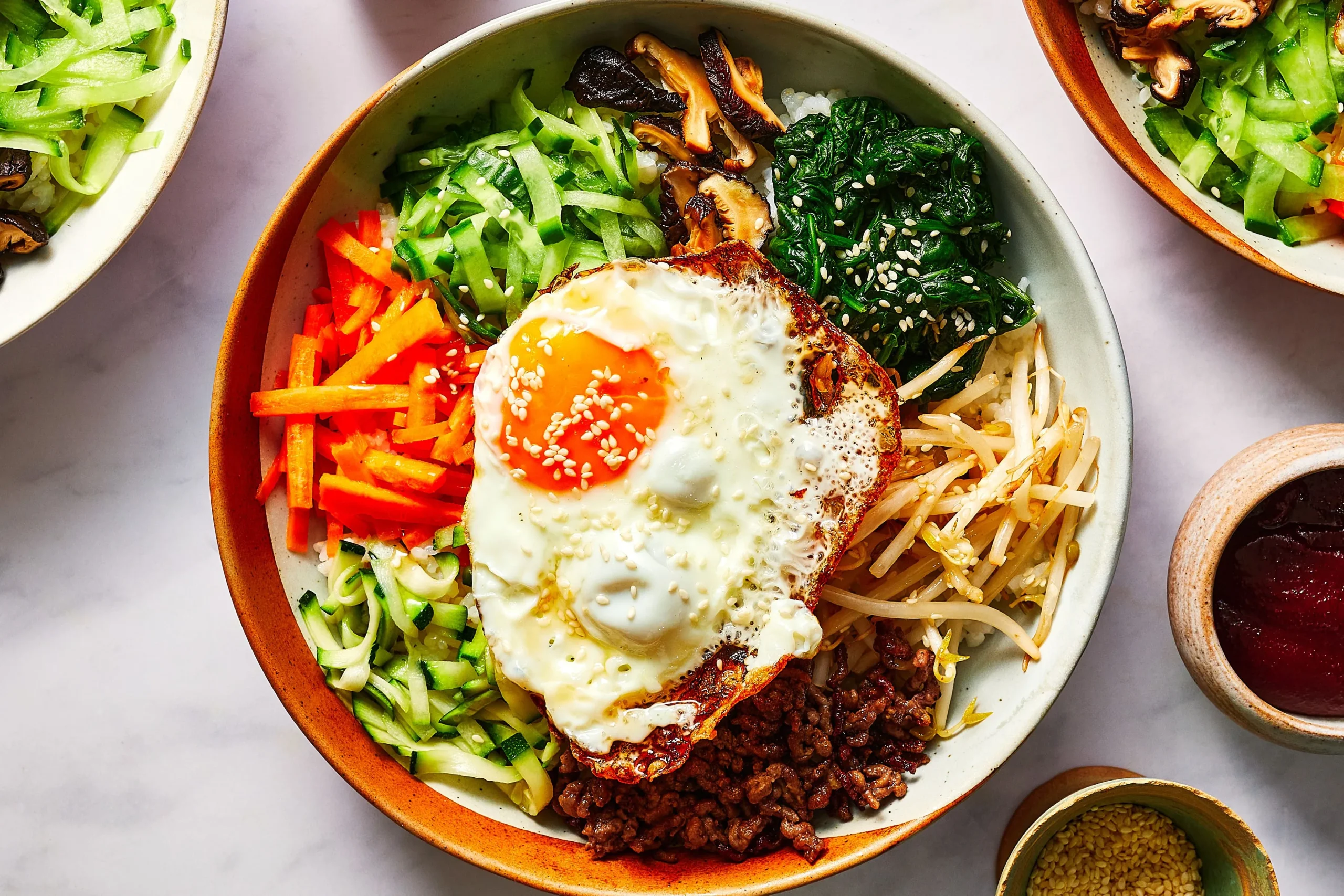
Bibimbap, a beloved traditional Korean dish, boasts a rich history and cultural significance. This flavorful meal, over 600 years old, features a harmonious mix of rice, vegetables, meat, and spicy gochujang sauce. Celebrated for its vibrant colors, diverse textures, and balanced nutrition, bibimbap is a versatile dish that continues to captivate food enthusiasts worldwide. Here are 25 intriguing facts that highlight the unique aspects and enduring appeal of bibimbap.
Bibimbap is a traditional Korean dish that has its origins in the Joseon Dynasty, making it over 600 years old. This era, spanning from 1392 to 1897, was characterized by significant cultural and culinary developments in Korea. Bibimbap’s history is intertwined with royal court cuisine and the country’s agrarian lifestyle. Initially, it was a simple farmer’s meal, allowing them to mix leftovers with rice, which evolved into a beloved national dish. Over the centuries, bibimbap has maintained its popularity, reflecting Korea’s agricultural heritage and the ingenuity of its people in creating nutritious and flavorful meals from available ingredients.
The word “bibimbap” translates to “mixed rice” in Korean, succinctly describing the dish’s essence. The term comes from “bibim” (mixing) and “bap” (cooked rice), highlighting its primary preparation method. This name emphasizes the communal and interactive nature of the dish, where ingredients are mixed just before eating. The act of mixing symbolizes harmony and balance, core values in Korean culture. The name also underscores the flexibility of bibimbap, as it can incorporate a variety of ingredients, making it adaptable to different tastes and dietary needs.
Bibimbap typically consists of white rice topped with a variety of vegetables, meat, a fried egg, and spicy gochujang sauce. The vegetables often include spinach, carrots, bean sprouts, mushrooms, and zucchini, each prepared separately to maintain their distinct flavors and textures. The meat, usually beef, is marinated and cooked to enhance its taste. A perfectly fried egg, with a runny yolk, adds richness to the dish. Gochujang, a fermented red chili paste, brings a spicy and savory element, tying all components together. This combination creates a visually appealing and nutritionally balanced meal.
The dish is known for its vibrant colors, diverse textures, and balanced flavors, which make it both visually appealing and satisfying to eat. The color variety, from the green of spinach to the orange of carrots, the white of bean sprouts, and the red of gochujang, creates a feast for the eyes. Each ingredient contributes a unique texture, from the crunch of vegetables to the tenderness of meat and the creaminess of the egg yolk. The flavors are carefully balanced, with the sweetness of the rice, the umami of the meat, the freshness of the vegetables, and the spiciness of the gochujang.
Bibimbap is often served in a hot stone bowl called a dolsot, which helps to crisp the rice at the bottom. The dolsot is heated until very hot before the ingredients are added, causing the rice to sizzle and form a crispy layer. This crust, known as “noo-roong-ji,” adds a delightful crunch and a slightly nutty flavor to the dish. The hot bowl also keeps the food warm for a longer period, allowing diners to enjoy a hot meal throughout their eating experience. The use of dolsot elevates bibimbap, making it a unique culinary experience.
There are many regional variations of bibimbap in Korea, with each region adding its own unique ingredients and flavors. For example, Jeonju bibimbap, one of the most famous types, is known for its use of high-quality local ingredients and its intricate preparation methods. Jeonju bibimbap often includes raw beef and a variety of unique vegetables. Other regions might include seafood, wild greens, or special sauces. These regional differences reflect the local culture and agricultural products, showcasing the diversity of Korean cuisine.
Bibimbap is considered a healthy dish due to its high vegetable content and balanced nutrition. The various vegetables provide essential vitamins and minerals, while the rice offers carbohydrates for energy. The meat, often lean, provides protein, and the egg adds both protein and healthy fats. Gochujang, made from fermented soybeans and chili peppers, also contributes beneficial probiotics. This combination makes bibimbap a nutrient-dense meal that supports a balanced diet, promoting overall health and wellness.
In 2011, bibimbap was listed in the World’s 50 most delicious foods by CNN Travel. This recognition highlights its global appeal and the growing popularity of Korean cuisine. CNN’s list is curated by food experts and based on reader votes, reflecting both expert opinion and public taste. Being included in this list has helped raise international awareness of bibimbap, attracting food enthusiasts from around the world to try this iconic Korean dish and contributing to the global spread of Korean culinary traditions.
The Guinness World Record for the largest bibimbap weighed over 7,700 pounds and was made in South Korea in 2014. This monumental effort involved hundreds of volunteers and a variety of ingredients sourced from across the country. The event aimed to promote Korean cuisine and showcase the communal spirit of Korean culture. The giant bibimbap was prepared in a massive bowl, and after the record was verified, it was shared with attendees, emphasizing the dish’s role in bringing people together.
Bibimbap is a popular choice among vegetarians and vegans, as it can easily be made without meat or with tofu as a substitute. The dish’s versatility allows for a wide range of plant-based ingredients, making it suitable for various dietary preferences. Vegetarians can enjoy bibimbap with a variety of vegetables, tofu, and a fried egg, while vegans can omit the egg and use extra tofu or mushrooms for protein. This adaptability has contributed to its popularity among those seeking nutritious and flavorful plant-based meals.
Bibimbap is often enjoyed with banchan, which are small side dishes served alongside the main meal. Banchan can include a variety of fermented, pickled, or freshly prepared items such as kimchi, seasoned spinach, pickled radish, and stir-fried anchovies. These side dishes add additional flavors, textures, and nutritional benefits to the meal, enhancing the overall dining experience. The assortment of banchan reflects the Korean philosophy of balance and variety in meals, providing a complementary contrast to the main components of bibimbap.
Bibimbap is commonly eaten on Jeonju Bibimbap Day in South Korea, celebrated on October 20th each year. This day is dedicated to honoring the traditional dish and promoting its cultural significance. Various events, including cooking competitions, tastings, and festivals, are held in Jeonju and other parts of the country to celebrate bibimbap. The day emphasizes the importance of preserving and promoting Korea’s culinary heritage, encouraging both locals and visitors to appreciate and enjoy bibimbap.
The Korean city of Jeonju is famous for its bibimbap, known for using high-quality ingredients and traditional preparation methods. Jeonju bibimbap stands out for its use of locally sourced vegetables, raw beef, and unique toppings such as egg yolk and mung bean jelly. The city’s commitment to maintaining authentic cooking techniques and ingredient quality has earned it a reputation as the birthplace of the best bibimbap. Jeonju’s rich culinary history and dedication to preserving traditional flavors make it a must-visit destination for bibimbap enthusiasts.
Bibimbap is a versatile dish that can be customized to suit individual preferences, making it a favorite among food enthusiasts. The basic components of bibimbap can be adjusted to accommodate different tastes, dietary restrictions, and ingredient availability. Diners can choose their preferred vegetables, protein sources, and levels of spiciness by adjusting the amount of gochujang. This adaptability allows for endless variations and personalization, ensuring that each serving of bibimbap can be a unique and satisfying experience.
The Bibimbap Backpackers Hostel in Seoul offers cooking classes where visitors can learn to make authentic bibimbap. These classes provide a hands-on experience, teaching participants about the ingredients, preparation techniques, and cultural significance of the dish. By participating in these classes, visitors can gain a deeper appreciation for Korean cuisine and take home the skills to recreate bibimbap. The hostel’s focus on culinary education highlights the growing interest in Korean food and its cultural heritage among international travelers.
The dish is often garnished with sesame oil and sesame seeds, adding a nutty flavor and aroma. Sesame oil, made from toasted sesame seeds, is a staple in Korean cooking, known for its rich, aromatic quality. A drizzle of sesame oil enhances the overall taste of bibimbap, while a sprinkle of sesame seeds adds texture and a subtle crunch. These garnishes not only elevate the flavor profile of the dish but also contribute to its visual appeal, making bibimbap a delightful sensory experience.
Bibimbap is a popular choice for a packed lunch or picnic due to its portability and ease of preparation. The ingredients can be prepped in advance and assembled when ready to eat, making it a convenient meal option. The dish can be enjoyed at room temperature, and its balanced nutrition makes it a satisfying choice for on-the-go meals. Its versatility and simplicity make bibimbap a practical and enjoyable option for various dining occasions, whether at work, school, or during outdoor activities.
The Korean film “Le Grand Chef” features a scene where bibimbap plays a central role in a culinary competition. The movie, which revolves around the world of competitive cooking, highlights the significance of bibimbap as a representative dish of Korean cuisine. The scene emphasizes the artistry and skill involved in preparing bibimbap, showcasing its importance in Korean culinary culture. This cinematic portrayal has helped raise awareness and appreciation for bibimbap among international audiences, contributing to its global popularity.
Bibimbap is often recommended as a comfort food for its satisfying and comforting qualities. The combination of warm rice, flavorful vegetables, savory meat, and spicy gochujang creates a hearty and fulfilling meal. Its balanced nutrition and rich flavors provide both physical sustenance and emotional comfort, making it a go-to dish for many Koreans and food lovers worldwide. The simplicity and wholesomeness of bibimbap make it an ideal choice for those seeking a nourishing and comforting dining experience.
The dish is celebrated during the annual Bibimbap Festival in Gyeongju, South Korea, featuring cooking competitions and tastings. This festival brings together chefs, food enthusiasts, and tourists to celebrate bibimbap and its cultural significance. Participants can enjoy various events, such as live cooking demonstrations, workshops, and food markets, where they can taste different variations of bibimbap. The festival aims to promote Korean culinary traditions, encourage creativity in bibimbap preparation, and provide a platform for sharing and enjoying this beloved dish.
Bibimbap is a favorite among health-conscious individuals due to its high fiber content and low saturated fat. The dish’s abundance of vegetables provides essential vitamins, minerals, and dietary fiber, which support digestive health and help maintain a healthy weight. The lean protein sources, such as tofu or chicken, and the minimal use of saturated fats contribute to its overall nutritional profile. The combination of complex carbohydrates from rice and the variety of fresh ingredients makes bibimbap a well-rounded meal that aligns with healthy eating principles.
The Bibimbap Museum in Jeonju showcases the history and cultural significance of the dish through interactive exhibits and workshops. Visitors to the museum can explore the origins of bibimbap, its evolution over centuries, and its role in Korean cuisine and culture. Interactive displays and hands-on activities allow guests to engage with the preparation and presentation of bibimbap. The museum also offers workshops where participants can learn to make their own bibimbap, deepening their understanding and appreciation of this iconic dish.
Bibimbap is a popular choice for travelers looking to experience authentic Korean cuisine, as it encapsulates the essence of Korean flavors. The dish’s combination of fresh vegetables, marinated meats, and spicy gochujang provides a comprehensive introduction to the key components of Korean cooking. Its vibrant presentation and balanced taste make it an attractive option for those new to Korean food. As a result, bibimbap is often recommended by travel guides and culinary experts as a must-try dish for visitors to South Korea.
The Korean Tourism Organization promotes bibimbap as a must-try dish for visitors to South Korea, highlighting its cultural importance. Through various marketing campaigns and promotional materials, the organization emphasizes bibimbap’s role in Korean culinary heritage. They showcase the dish at international food festivals, cultural events, and through online platforms, aiming to attract food enthusiasts from around the world. By promoting bibimbap, the Korean Tourism Organization helps to boost tourism and increase global awareness of Korea’s rich culinary traditions.
Bibimbap is recognized as an iconic Korean dish that represents the country’s culinary heritage and creativity. Its ability to incorporate a wide range of ingredients and adapt to different regional styles demonstrates the diversity and innovation inherent in Korean cuisine. Bibimbap’s popularity both domestically and internationally underscores its status as a cultural ambassador for Korea. The dish not only reflects traditional cooking methods and local flavors but also showcases the creativity and adaptability of Korean chefs in creating a meal that is both nutritious and delicious.
Bibimbap FAQs
Here are some of the most commonly asked questions about Bibimbap:
What is Bibimbap?
Bibimbap (pronounced BEE-bim-bap) is a Korean rice dish that translates literally to “mixed rice.” It’s a colorful and visually appealing bowl filled with fluffy white rice, a variety of seasoned vegetables, a fried or sunny-side-up egg, and a dollop of gochujang (Korean red chili paste) for a sweet and spicy kick.
What are the typical ingredients in Bibimbap?
The beauty of Bibimbap lies in its customizability. However, there are some common ingredients you’ll find in most bowls:
- Base: Steamed white rice is the foundation of Bibimbap.
- Vegetables: Typically, there’s a colorful assortment of seasoned and sauteed vegetables like spinach, bean sprouts, julienned zucchini, and thinly sliced mushrooms. Kimchi, the spicy fermented cabbage, is also a frequent addition.
- Protein: Bibimbap can be vegetarian, but some variations include bulgogi (marinated grilled beef), sliced pork, or even seafood.
- Egg: A sunny-side-up or fried egg adds richness and protein to the dish.
- Gochujang: This bright red chili paste is the heart and soul of Bibimbap’s flavor profile. It adds a sweet, spicy, and savory note.
- Other toppings: Sesame seeds, toasted seaweed (gim), and julienned omelet can also be found in some Bibimbap bowls.
What are some regional variations of Bibimbap?
Bibimbap is a versatile dish with regional variations across Korea. Here are a couple of popular ones:
- Dolsan Bibimbap: This version from Jeonju features a wider variety of ingredients, sometimes up to 30, including julienned vegetables, mung bean sprouts, nuts, and even sliced beef or seafood.
- Yeonpung Bibimbap: This seafood Bibimbap comes from the coastal town of Yeongdeungpo and uses fresh shellfish and sea vegetables.
How is Bibimbap traditionally served?
Bibimbap is usually served in a heated stone pot (dolsot) which keeps the rice crispy at the bottom. All the ingredients are arranged around the rice, and a raw egg yolk is placed in the center. The fun part comes with mixing everything together – rice, vegetables, meat, egg, and the gochujang – for a delicious and flavorful bite.
What are some tips for enjoying Bibimbap?
- Get the sizzle: The dolsot stone pot is key to the Bibimbap experience. The hot pot creates a crispy rice layer at the bottom, so make sure it’s sizzling hot when served.
- Mix it up: Don’t be shy! The beauty of Bibimbap lies in combining all the textures and flavors. Thoroughly mix everything together in the pot for an even and delightful experience.
- Start slow with the gochujang: Gochujang can range in spiciness. Add a little at first and taste as you go before adding more.
- Enjoy the variety: Bibimbap is a very customizable dish. Feel free to add or remove ingredients based on your preference.
Is Bibimbap vegetarian?
While some Bibimbap variations include meat or seafood, it can definitely be made vegetarian. Just skip the meat and focus on a wider variety of vegetables and kimchi. You can also add a fried tofu cube for extra protein.








